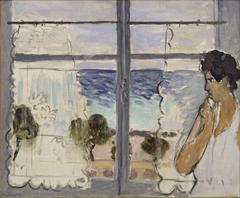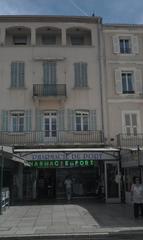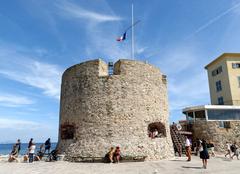Citadelle de Saint-Tropez: Visiting Hours, Tickets, and Travel Tips
Publishing Date: 18/07/2024
Introduction to Citadelle de Saint-Tropez
Today, the Citadelle de Saint-Tropez not only preserves the town’s storied past but also provides breathtaking panoramic views of the Golfe de Saint-Tropez, the village, and the Maures Mountains. Whether you’re a history enthusiast, an architecture aficionado, or simply seeking stunning vistas, the citadel promises a memorable journey through time.
Contents Overview
- A Fortress Rises: Birth of the Citadelle
- Architectural Prowess and Military Might
- Enduring Conflicts: A Timeline of Resistance
- From Battlefield to Barracks: A Changing Role
- A New Chapter: Preserving History and Heritage
- The Musée d’Histoire Maritime: A Journey Through Time
- Visitor Information
- Travel Tips
- Nearby Attractions
- Panoramic Views and Photographic Delights
- FAQ
A Fortress Rises: Birth of the Citadelle
The Citadelle de Saint-Tropez, a formidable sentinel overlooking the azure waters of the Mediterranean, boasts a history as captivating as the panoramic views it offers. Its story begins not in an era of luxury yachts and celebrity sightings, but in a time of turbulent power struggles and maritime threats.
The late 16th and early 17th centuries saw the rise of Spanish power in the region. Fearing encroachment on their territory and seeking to protect the vital port of Saint-Tropez, the Duke of Guise, representing the French Crown, commissioned the construction of a defensive structure. Thus, in 1589, work began on the citadel, marking the first chapter in its long and storied existence.
Architectural Prowess and Military Might
The citadel’s design, a testament to the military architecture of the time, was entrusted to the renowned engineer Jean-Baptiste Erard. He envisioned a fortress capable of withstanding powerful sieges, incorporating innovative features like angled bastions for improved cannon fire and thick, sloping walls to deflect enemy projectiles.
Completed in 1607, the Citadelle de Saint-Tropez quickly proved its worth. Its strategic location at the mouth of the Golfe de Saint-Tropez allowed it to control maritime traffic and defend against enemy incursions. The citadel’s cannons, capable of firing over a long range, served as a powerful deterrent to potential attackers.
Enduring Conflicts: A Timeline of Resistance
Throughout the 17th century, the Citadelle de Saint-Tropez played a pivotal role in various conflicts, standing as a steadfast symbol of resistance against hostile forces.
- 1637: The citadel successfully repelled a Spanish naval attack, demonstrating its defensive capabilities.
- 1672: During the Franco-Dutch War, the citadel once again served as a crucial defensive stronghold.
- 1742-1748: The War of the Austrian Succession saw the citadel further fortified and its garrison strengthened, highlighting its continued importance in regional power dynamics.
From Battlefield to Barracks: A Changing Role
As the 18th century progressed and the nature of warfare evolved, the Citadelle de Saint-Tropez’s role gradually shifted. No longer facing significant threats from the sea, the fortress transitioned into a barracks, housing French troops. This period marked a change in the citadel’s function, but its imposing presence continued to loom large over the town of Saint-Tropez.
A New Chapter: Preserving History and Heritage
In the 20th century, the Citadelle de Saint-Tropez embarked on a new chapter in its long history. Recognizing its historical and architectural significance, the French government classified the citadel as a monument historique in 1921, ensuring its preservation for generations to come.
This designation paved the way for the citadel’s transformation into a museum, a project that came to fruition in 1958. The Musée d’Histoire Maritime de Saint-Tropez, housed within the citadel’s walls, opened its doors to the public, offering a fascinating glimpse into the town’s rich maritime heritage.
The Musée d’Histoire Maritime: A Journey Through Time
The Musée d’Histoire Maritime de Saint-Tropez, housed within the citadel’s atmospheric chambers, invites visitors to delve into the captivating story of Saint-Tropez’s relationship with the sea. Through a compelling collection of artifacts, models, and interactive exhibits, the museum traces the town’s maritime journey from its humble beginnings as a fishing village to its rise as a renowned port and, later, a glamorous seaside resort.
The museum’s exhibits showcase:
- Ancient Maritime Traditions: Discover the early fishing techniques and shipbuilding practices that shaped the lives of Saint-Tropez’s inhabitants for centuries.
- Naval Prowess: Explore the town’s role in naval history, from its strategic importance in regional conflicts to the stories of local sailors who served in the French Navy.
- Trade and Commerce: Trace the evolution of Saint-Tropez’s port, from its early days as a hub for local trade to its development into a bustling center of international commerce.
- The Rise of Tourism: Witness the transformation of Saint-Tropez into a world-renowned tourist destination, attracting artists, celebrities, and travelers from across the globe.
Visitor Information
To make the most of your visit to the Citadelle de Saint-Tropez, here are some essential details:
- Visiting Hours: The citadel is open daily from 10:00 AM to 6:00 PM. Hours may vary during holidays and special events, so it’s advisable to check ahead.
- Tickets: Admission prices are €8 for adults, €4 for children aged 7-17, and free for children under 7. Discounts are available for groups and senior citizens.
- Guided Tours: Guided tours are available and highly recommended to enhance your understanding of the citadel’s history and architecture. Tours are conducted in multiple languages.
- Accessibility: The citadel is partially accessible to visitors with reduced mobility. However, due to its historic nature, some areas may have limited access.
Travel Tips
- Getting There: Saint-Tropez is accessible by car, bus, and boat. During peak tourist season, consider using public transportation or parking outside the town center and walking to the citadel.
- Best Time to Visit: Spring and early autumn offer pleasant weather and fewer crowds, making it ideal for exploring the citadel and enjoying the panoramic views.
- What to Bring: Comfortable walking shoes, a hat, sunscreen, and a camera are essential for a day at the citadel.
Nearby Attractions
While in Saint-Tropez, consider visiting these nearby attractions:
- Place des Lices Market: A vibrant market offering local produce, crafts, and antiques, held every Tuesday and Saturday morning.
- La Maison des Papillons: A charming butterfly museum showcasing a vast collection of butterfly specimens from around the world.
- Pampelonne Beach: One of the most famous beaches in Saint-Tropez, perfect for a relaxing day by the sea.
Panoramic Views and Photographic Delights
Beyond its historical significance and captivating museum, the Citadelle de Saint-Tropez offers visitors breathtaking panoramic views of the surrounding landscape. From its elevated position, the citadel provides unparalleled vistas of:
- The Golfe de Saint-Tropez: Gaze out over the sparkling blue waters of the gulf, dotted with sailboats and luxury yachts, a testament to Saint-Tropez’s enduring allure.
- The Village of Saint-Tropez: Admire the charming terracotta rooftops and pastel-colored buildings of the village, nestled amidst lush greenery, a picturesque scene that has captivated artists and travelers for generations.
- The Maures Mountains: Witness the rugged beauty of the Maures Mountains, their slopes cloaked in verdant vegetation, providing a dramatic backdrop to the azure waters of the Mediterranean.
The citadel’s vantage point offers ample opportunities for capturing stunning photographs, making it a must-visit destination for photography enthusiasts. Whether capturing the panoramic views, the intricate architectural details of the fortress, or the captivating exhibits within the museum, visitors are sure to leave with lasting memories of their visit.
FAQ
- What are the visiting hours for Citadelle de Saint-Tropez? The citadel is open daily from 10:00 AM to 6:00 PM. Hours may vary during holidays and special events.
- How much are the tickets for Citadelle de Saint-Tropez? Admission prices are €8 for adults, €4 for children aged 7-17, and free for children under 7.
- Is the citadel accessible for visitors with reduced mobility? The citadel is partially accessible, though some areas may have limited access due to its historic nature.
- Are guided tours available? Yes, guided tours are available in multiple languages and are highly recommended.
Summary and Final Thoughts
For those planning a visit, spring and early autumn provide the best weather conditions and fewer crowds, ensuring a more enjoyable exploration of this iconic landmark. Don’t forget to check the official website for the latest updates on visiting hours, ticket prices, and guided tours. To stay informed and connected, consider downloading the mobile app Audiala and following the Citadelle de Saint-Tropez on social media for the latest news and travel tips.


